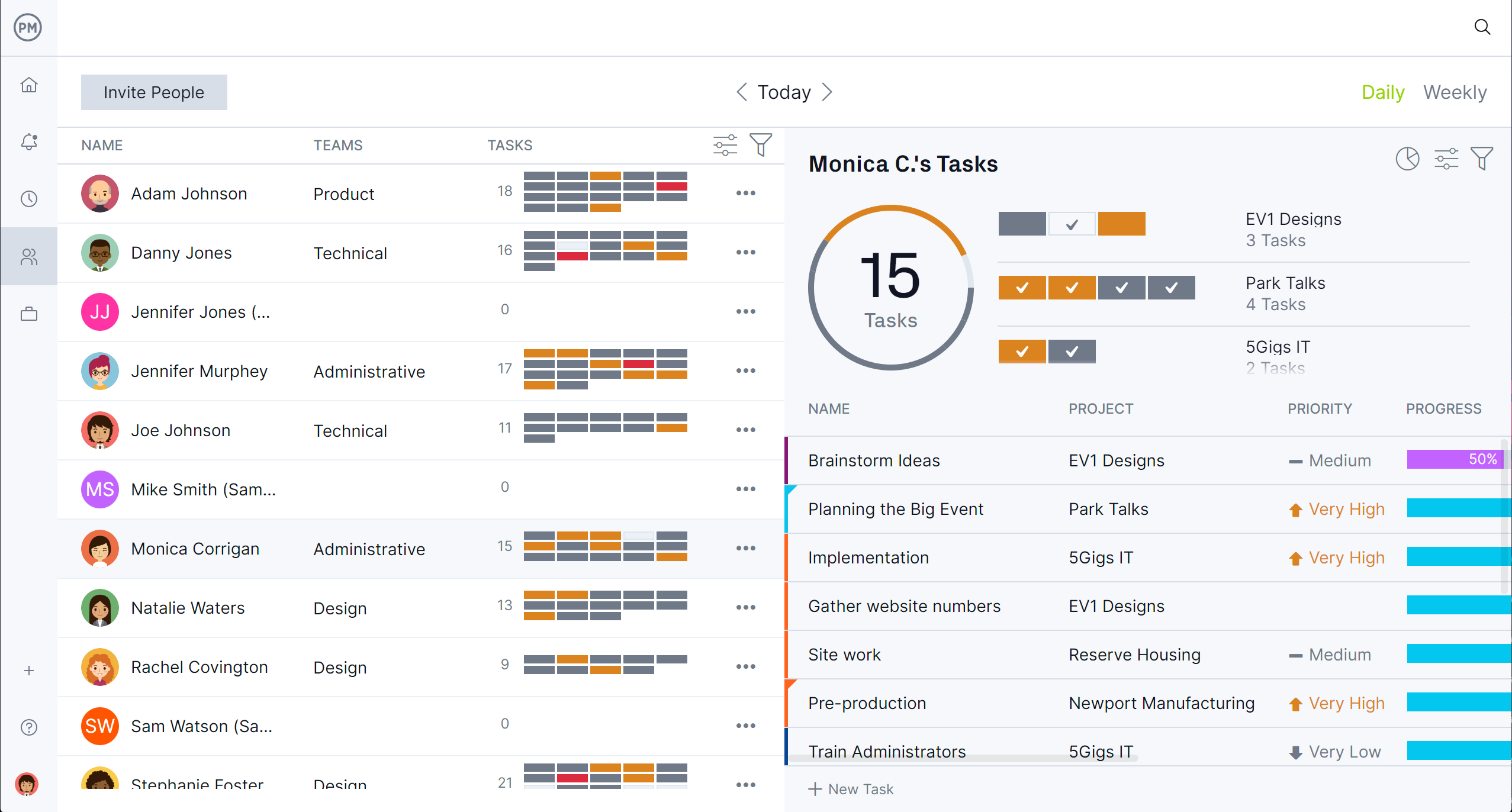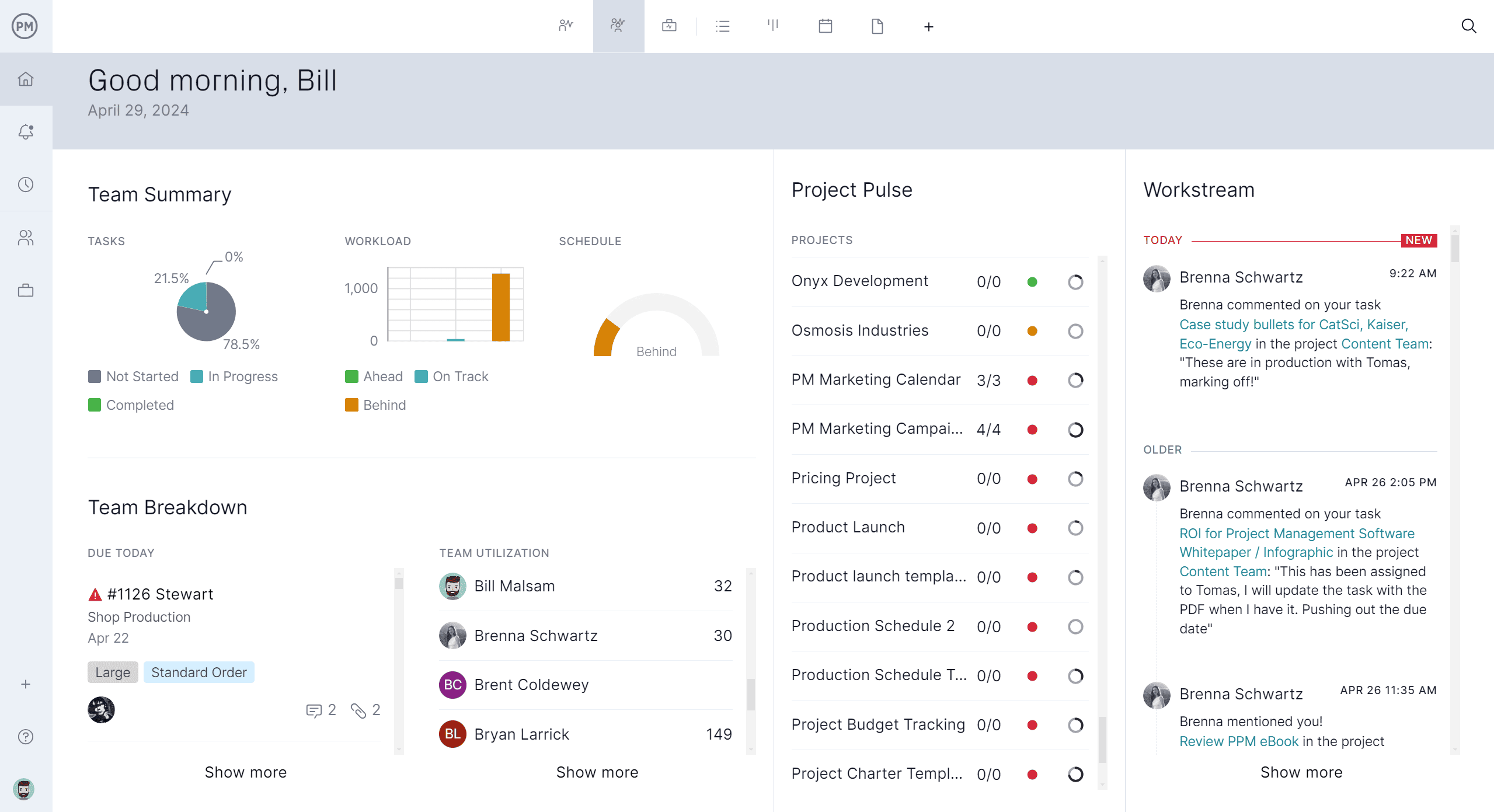Technology projects move fast and things change on a dime. Having a clear and structured plan is essential to aligning IT initiatives with broader business goals. That’s where an IT roadmap comes in. An IT strategy roadmap is a planning tool that outlines how an organization will evolve its technology over time, covering everything from infrastructure upgrades and software development to cybersecurity improvements and cloud migration strategies.
Before we get to all that, though, we’ll define what an IT roadmap is, what should be included in one and how you can create one that supports both long-term vision and short-term execution. To help you get started, we’ve also included a customizable IT roadmap template that you can tailor to your organization’s unique priorities and timelines.
What Is an IT Roadmap?
An IT roadmap is a strategic document that outlines how an organization plans to use technology to support its business goals over a specific timeframe. It serves as a high-level visual guide for planning and prioritizing IT initiatives such as infrastructure upgrades, software implementation, cybersecurity improvements and cloud migration. The roadmap details what technologies will be adopted, when they will be deployed and how they align with business needs, helping stakeholders understand the direction and value of IT investments.
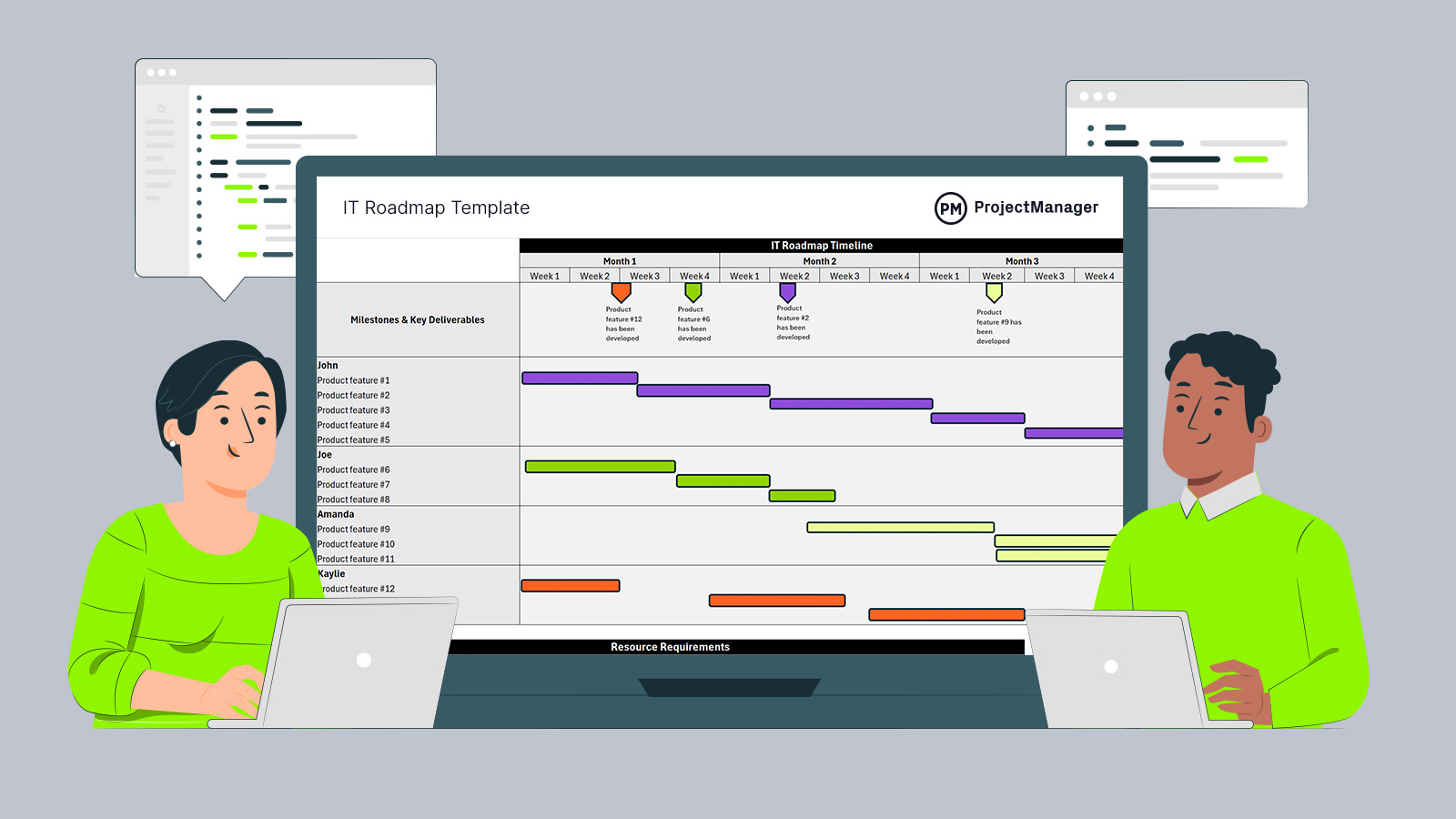
Get your free
IT Roadmap Template
Use this free IT Roadmap Template to manage your projects better.
Get the Template
Beyond just listing projects, an IT roadmap helps coordinate cross-functional teams, manage resources and track progress against long-term objectives. It ensures that all stakeholders—from IT departments to executive leadership—are aligned on technology priorities and timelines. By using an IT roadmap, organizations can reduce redundancy, improve scalability and make more informed decisions about budgeting and resource allocation.
While it looks like a Gantt chart, an IT roadmap is more expansive, including the context, strategy, project breakdowns, timing and sequencing, resources and budget plans and governance. Think of a Gantt chart as a delivery timeline, while the full IT roadmap is the blueprint guiding everything, technically and strategically. We have an IT roadmap template for free, but we recommend project management software.
ProjectManager is award-winning project and portfolio management software with comprehensive IT roadmaps designed to provide a strategic, high-level view of projects, programs and portfolios. These tools help with strategic alignment, ensuring all stakeholders understand the project’s direction. It also integrates with resource management, time tracking and task management features to ensure projects stay on track. Get started with ProjectManager today for free.
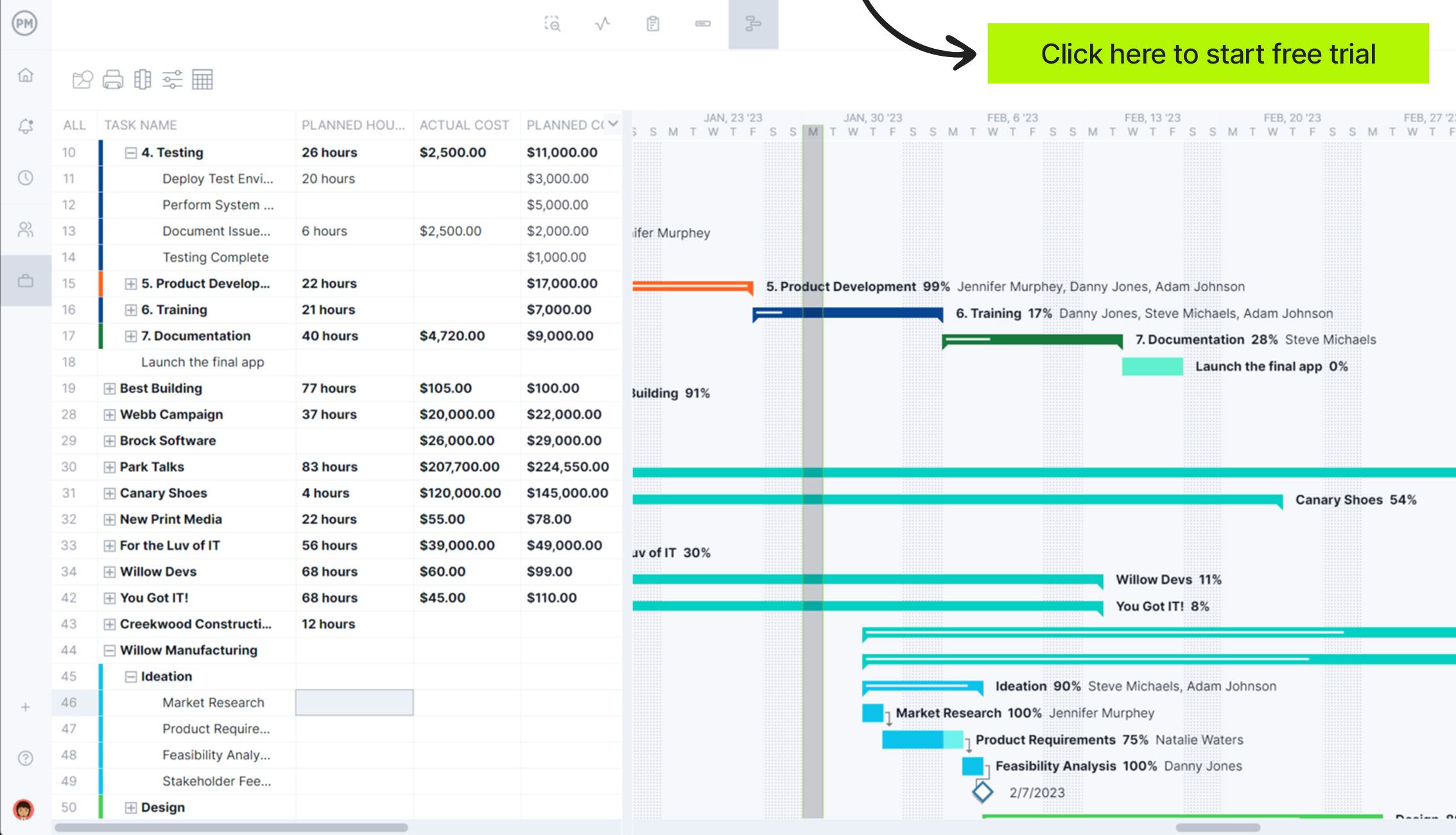
What Should Be Included in an IT Roadmap?
An effective IT roadmap provides a clear and comprehensive view of how an organization plans to use technology to meet its strategic goals. Whether you’re introducing new infrastructure, upgrading software or enhancing cybersecurity, a well-structured IT roadmap aligns technology initiatives with business objectives. Here’s what should be included in an IT roadmap to ensure it serves as a reliable and actionable guide.
1. Executive Summary
This section provides a high-level overview of the roadmap, outlining its purpose, scope and alignment with the organization’s broader strategic vision. It’s aimed at stakeholders and decision-makers who need a concise summary of the roadmap’s goals.
2. Current IT Environment
This is a snapshot of the organization’s existing IT infrastructure, systems, tools and capabilities. This baseline helps identify gaps, limitations and opportunities for improvement. It should include the following.
- Infrastructure: Describes the physical and virtual computing environment, including on-premises servers, data centers and cloud hosting platforms.
- Network: Covers internal and external connectivity such as LAN/WAN architecture, VPN access, firewalls, bandwidth and network redundancy.
- End-User Devices: Refers to the hardware employees use, including desktops, laptops, mobile devices and their operating systems.
- Applications: Lists core business software in use, such as ERP (Enterprise Resource Planning), CRM (Customer Relationship Management), HRIS (Human Resources Information Systems) and collaboration tools.
- Data Storage: Involves how data is stored, backed up and retained, including total capacity, storage types and backup protocols.
- Security: Encompasses tools and processes to protect IT assets, such as antivirus software, multi-factor authentication (MFA), encryption and vulnerability management.
- IT Service Management (ITSM): Includes the systems and workflows used to manage IT support, including helpdesk software, ticket resolution processes, SLAs and response times.
- Integration Points: Describes how systems communicate using APIs, middleware and third-party software connections.
- Licensing & Compliance: Tracks software licensing agreements, renewal schedules and adherence to industry regulations such as GDPR or HIPAA.
- IT Team: Outlines the structure of the internal IT department, including team roles, skillsets and headcount.
- Vendors & Contracts: Identifies key external technology partners, service providers and the status of contractual agreements.
- Pain Points: Highlights current challenges or limitations within the IT environment, such as aging hardware or unsupported legacy systems.
3. Strategic IT Goals
These are defined objectives that the IT roadmap aims to achieve. These goals should align with business strategy and might include goals such as improving system reliability, enhancing cybersecurity or enabling digital transformation.
4. Key Initiatives and Projects
This is the core of the roadmap, detailing the major IT initiatives and projects planned to achieve the strategic goals. Each project should include a brief description, objectives, timelines and responsible teams.
5. IT Roadmap Timeline
A visual or tabular representation of when each initiative will be executed. This timeline is like a Gantt chart, showing activities required to meet the IT goals. It ensures alignment across departments and helps with planning and resource allocation.
6. Resource Requirements
Outlines the personnel, tools, hardware and software needed to execute the roadmap. Resource requirements are essential for assessing feasibility and ensuring appropriate resource planning.
7. IT Roadmap Budget
A financial estimate for the initiatives and projects included in the roadmap. It should include capital expenses, operational costs and contingency funds.
8. Risk Management Plan
Identifies potential risks that could affect the roadmap’s success, along with mitigation strategies. Common risks include vendor delays, scope creep or cybersecurity threats.
9. Performance Metrics and KPIs
Defines how progress and success will be measured. Common IT KPIs include system uptime, project completion rate and return on technology investment.
10. IT Governance Structure
Details the roles, responsibilities and decision-making processes for overseeing the roadmap’s execution. This section ensures accountability and consistency in implementation.
11. Communication Plan
Describes how the roadmap and its progress will be communicated to stakeholders, including reporting frequency, formats and key audiences. This promotes transparency and engagement.
Benefits of an IT Roadmap
An IT roadmap delivers numerous strategic and operational benefits, helping organizations align their technology initiatives with long-term business goals. Here are some of the key advantages.
- Stronger strategic alignment
- Improved prioritization and planning
- Enhances communication and transparency
- Better risk management
- Resource optimization
- Adaptability to change
IT Roadmap Template
Now that we understand more thoroughly what an IT roadmap is, readers are most likely eager to get their hands on one to use it or, at least, play around with the tool to get a better understanding of its usefulness. Download our free IT roadmap template for Excel and give it a try.
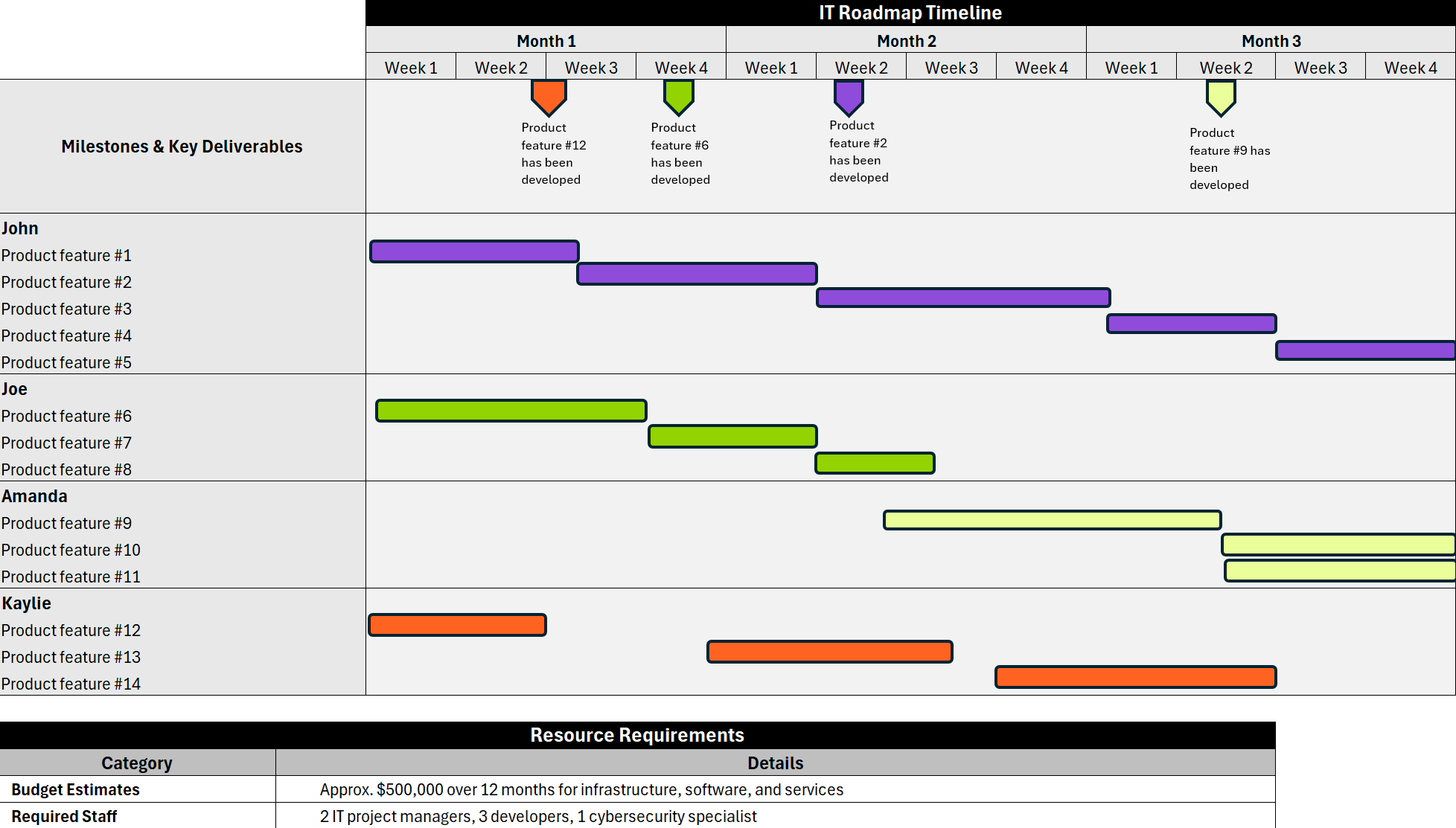
This free IT roadmap template helps organizations plan, organize and communicate their technology strategy over time. It serves as a guide for outlining current IT capabilities, future technology initiatives and the steps needed to bridge the gap between them.
Related IT Templates
There are more IT templates than the IT roadmap. In fact, there are over 100 free project management templates available for immediate download. They cover all aspects of managing a project across multiple industries. Here are just a few that are appropriate for IT.
IT Project Plan Template
Open this free IT project plan template in ProjectManager to help project managers organize, document and communicate the key components of an IT project. It outlines what the project will deliver, how it will be executed, who will be involved and how progress will be tracked—serving as a comprehensive blueprint for successful project execution.
IT Risk Assessment Template
Download this free IT risk assessment template for Excel to identify, evaluate and prioritize potential risks to an organization’s information technology systems, infrastructure and operations. It provides a repeatable process for analyzing vulnerabilities and threats so that mitigation strategies can be developed proactively.
Agile Sprint Plan Template
Use this free agile sprint plan template to organize and manage work during a sprint (a short, time-boxed development cycle, typically one to four weeks). It helps teams outline what they aim to accomplish during the sprint, track progress and ensure alignment across team members.
How ProjectManager Helps Manage IT Projects
It may feel odd using outdated technology like templates to manage an IT project. Yes, they can provide a free workaround, but they’re limited, requiring manual updates and not built for collaboration. It’s unlikely to find IT teams working with templates. Understandably, they prefer project management software.
ProjectManager is award-winning project and portfolio management software that has multiple project views that allow IT teams to work on kanban boards, but cross-functional teams to use tools that are more appropriate for their work, whether that’s Gantt charts, task, sheet or calendar views. All project views are updated in real time to keep teams collaborating and working on the same page.
Allocate and Monitor Resources
Our software enables IT teams to allocate and monitor resources, whether people, equipment or budgets, in real time. For example, our color-coded workload chart makes it easy to see who is overallocated or underutilized and balances the team’s workload to keep them productive.
When teams are onboarded, their availability can be set to make assignments based on actual availability and skills. There’s even a team page for a daily or weekly summary of their activity, which can be filtered by progress or priority. Tasks can be updated without leaving the page.

Track Tasks and Progress With Real-Time and Reports
Sticking to the IT project plan requires constant monitoring. Our real-time tracking features ensure that the collected data is updated and relevant. For a high-level overview, toggle over to the real-time project or portfolio dashboard for instant visibility into KPIs like task completion, resource utilization and budget health.
For further details, use our customizable reports on status, variance, timesheets, workload and more. They can be filtered to show the information you want to see. Even our secure timesheets help by tracking labor costs to help keep to the budget.

Related IT Management Content
An IT roadmap is part of the larger IT management process. For those readers curious to learn more about this discipline, below are some recent blog posts that expand on the subject.
- What Is IT Management? Why Is IT Important for Businesses?
- IT Service Management (ITSM): Frameworks, Processes & Phases
- What Is an IT Budget? IT Budgeting Basics
- IT Financial Management (ITFM) Best Practices
- IT Incident Management: How to Manage IT Incidents
- IT Risk Management Process, Frameworks & Templates
ProjectManager is online project and portfolio management software that connects teams whether they’re in the office or out in the field. They can share files, comment at the task level and stay updated with email and in-app notifications. Join teams at Avis, Nestle and Siemens who use our software to deliver successful projects. Get started with ProjectManager today for free.

